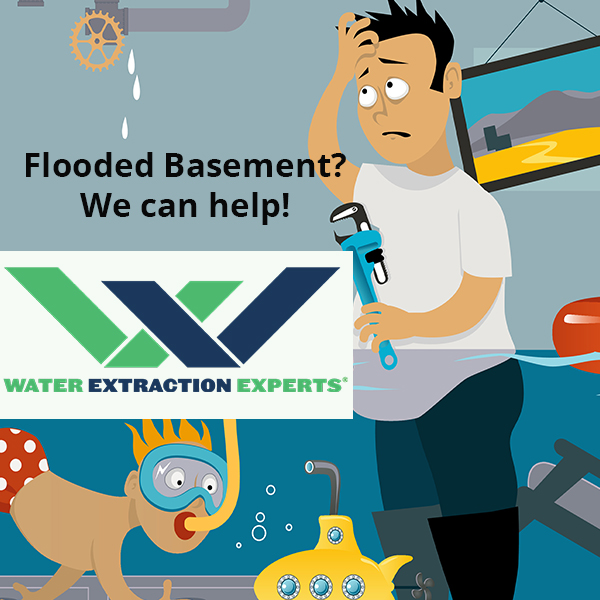
Your Basement is Flooded. Now what?
If you have a home in New Mexico, Colorado, or Wyoming you may know the perks of having a basement for storage and extra room. But you may also know that a basement can easily become flooded and the water damage can be a major ordeal.
Flooded Basement: First Steps
First things first, if your basement has become flooded, it’s important to call the professionals. Electrical currents can be carried through the water…so do not wade into the water if your basement is flooded. Make sure you’ve cut off all electricity to the basement. If you don’t know how, again…call a professional to come and help.
Turn off the water valve.
If the flooding is due to an internal source (water heater, broken pipe, or hose) make sure to turn off the water valve. Usually, there is a water valve in the basement. If the water is coming from the water heater, turn off the water valve located on the water heater.
Possible Causes of Flooded Basement
- Water Heater Failure
Just like any appliance in your home, water heaters may work great without any issues for years, and then suddenly, without warning, a complete failure occurs and you’ve got a sizeable flood in your home.
The average life of a water heater is about 10 years. Even before the 10-year mark hits, it’s important to check your water heater from time to time for leaks, as these leaks if they go unchecked can quickly turn into more costly repairs and lead to damage in your home. As a water heater gets older, the more likely it is that a failure will occur, so it’s wise to replace your water heater—even if it seems to still be in working order—if the appliance is more than 10 years old. The cost of replacing a water heater in most instances far outweighs the chance of an old system failing and creating an even bigger fiasco with flood-damaged floors, drywall, and furniture. Learn more about water heater failures.
- Break-in Water Line
- Sump Pump isn’t Working
If you live in a rainy area, at the bottom of a hill, or in an area with a high water table—such as parts of Weld County in Colorado including Windsor and Greeley—there’s a good chance your house has a sump pump.
A sump pump is a small pump installed below the lowest part of a basement or crawlspace, often in a small specially constructed pit. The sump pump collects groundwater and pumps it away from your home’s foundation to keep the lowest areas of your house dry.
While it may seem like relatively few houses would need to worry about ground dampness, it’s estimated that more than 60 percent of all homes in the U.S. experience below-ground wetness and are susceptible to some level of flooding or unwanted moisture. And since 1987 sump pumps are actually a requirement in new construction homes, even in areas that aren’t at high risk for flooding.
So, what exactly should you know about your sump pump? It’s important to remember that sump pumps can fail, just like any other mechanical system in your home. For this reason, it’s key not to overlook this important little pump.
- Floor Drain is Clogged
- Water Seepage through Foundation
A house is only as strong as its foundation. So to keep your house strong for years to come, it’s important to protect your home’s foundation from water—both from the outside and from the inside.
Foundation water damage can cause cracking to occur, which can ultimately weaken your foundation, compromise the safety of your home, and lead to major repair expenses. Here are seven tips to help you avoid foundation water damage and give you peace of mind
6. Sewer Backup
The sewer lines in your home carry away all the waste from your sinks, tubs, toilets, and laundry, and most of us don’t give these plumbing lines a second thought…as long as they’re doing their job, that is. A sewer backup will all-too-quickly remind you of the necessity of this plumbing system performing at 100 percent. The sewer lines in your home are designed like a tree, with a mainline running from your house to the street and secondary lines running off of it that connects each drain to the mainline. Sewage backups can happen in the smaller secondary lines, due to clogs in the pipes or structural defects, or in the mainline, due to issues like tree root infiltration or if there has been wet weather and flooding around your home.
It’s important to keep an eye out for early warning signs of sewage backup, as the issue can quickly turn from a slightly annoying slow drain to an overflowing toilet, bringing with it nasty bacteria and parasites that are hazardous to your family’s health.
7. Storm Water Coming through Window Wells
Whether it’s snow, heavy rain, or flood water, protecting your home from water damage goes beyond just having four sturdy walls and a well-built roof. The other half of the battle has to do with the characteristics of the property around your home and how that could affect your house during extreme weather. Here are tips to consider for protecting your home from stormwater damage:
8. Broken/Frozen Hose Bib
When the temperature drops low enough, sitting water inside pipes can freeze and, therefore, expand, putting extreme pressure on the pipe’s walls. And eventually, the ice creates enough pressure to cause the pipes to crack. Although a cracked pipe may seem unlikely or that a small crack couldn’t cause that much damage, even a 1/8-inch crack in a pipe can spew up to 250 gallons of water a day, causing flooding, major structural damage, and the immediate potential for dangerous mold growth. Cracked or burst pipes are one of the most common causes of property damage during the winter months, but they are also preventable! https://waterextractionexperts.com/5-easy-steps-to-protect-your-pipes-this-winter/
We can help with a flooded basement.
A flooded basement can be stressful and expensive to repair. We understand and can help you get back to normal as quickly and inexpensively as possible. We provide inspections and estimates. We work directly with your insurance company and provide all the necessary documentation to help ensure your claim is processed easily.
EMERGENCY 24/7 WATER, FIRE, STORM, DAMAGE SERVICES
CALL: 970-581-4498 Northern Colorado
CALL: 307-220-5900 Southeastern Wyoming
CALL: 505-250-6500 Albuquerque and Santa Fe, New Mexico Areas
